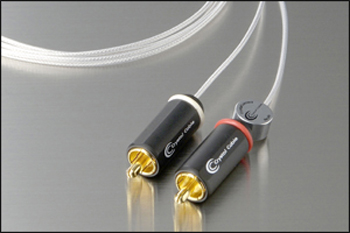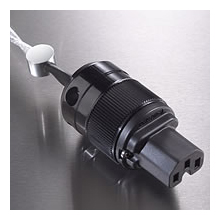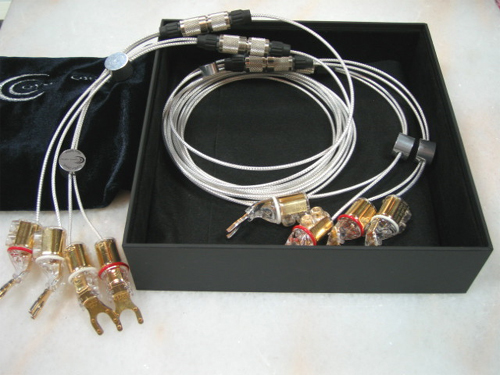
You are reading the older HTML site
Positive Feedback ISSUE
march/april 2007
crystal cable
Reference cables
as reviewed by John Brazier

|
JOHN BRAZIER'S SYSTEM
LOUDSPEAKERS
ELECTRONICS
SOURCES
CABLES
ACCESSORIES
|
The Reference products by Crystal Cable are not your typical garden hoses—quite the opposite. Barely thicker than an eighth of an inch, they are a departure from the "thick as your wrist" cables that dominate the audio industry. Just as faceplates have moved from black to silver, I think it is time to thin out our cables. I understand that this is a poor analogy, as the performance of a cable is more affected by its thickness than a piece of electronics is affected by the color of its faceplate, but the change is welcome, and in this case, there was no sacrifice in performance.
The CrystalSpeak Reference speaker cables also possess a capability that I found intriguing. About a half-meter from the end of each cable, there is a coupler that can be unscrewed and removed. Then, at the whim of the owner, the termination of the cable can be changed, or even the length. Removing and replacing the couplings is pretty much foolproof, as they are attached in the same way they are unattached. This is a nice feature, especially when compared to typically featureless cables, and a testament to the ingenuity of Crystal Cable.
When I contacted Crystal Cable about the possibility of a review, I did not have a particular type of cable in mind. Gabi van der Kley, the CEO and president of this Netherlands firm, convinced me of two things over the course of several emails: (1) that my gear warranted the use of the Reference cables, and (2) that I should install and review a complete system's worth of cable. She advised me that what I would hear if I used a single length of cable would be very much magnified if I used Crystal Cable throughout my system. This made sense to me, although it required much more time and effort that I had been prepared to devote. To do things right, I would have to install each pair of cables, burn them in, listen to their effect, add the next set of cables, then repeat the process until the entire system was rewired. In this way, I could determine the changes made by each set of cables before I evaluated their overall effect. It was a large commitment, but I accepted the challenge.
 First I replaced all
of my power cords with CrystalPower Reference cords. The ones I replaced
included Cardas Golden Cross on my NuForce Reference SE amplifiers and
Acoustic Zen El Ninos on my Naim XPSII power supply and Pass Labs X1
preamp. My first impression was that the sound had been physically
lifted about three feet higher than before. I had given the CrystalPower
cords a lot of burn-in time, but the sound had a slight "tinge" that
indicated more time was needed, and the problem dissipated over the next
week or so. With further listening, I realized that the CrystalPower
cords had not only raised the soundstage, but lowered the noise floor.
I'd thought that the darkness between musical notes couldn't get any
darker until these power cords came along to shift the paradigm.
First I replaced all
of my power cords with CrystalPower Reference cords. The ones I replaced
included Cardas Golden Cross on my NuForce Reference SE amplifiers and
Acoustic Zen El Ninos on my Naim XPSII power supply and Pass Labs X1
preamp. My first impression was that the sound had been physically
lifted about three feet higher than before. I had given the CrystalPower
cords a lot of burn-in time, but the sound had a slight "tinge" that
indicated more time was needed, and the problem dissipated over the next
week or so. With further listening, I realized that the CrystalPower
cords had not only raised the soundstage, but lowered the noise floor.
I'd thought that the darkness between musical notes couldn't get any
darker until these power cords came along to shift the paradigm.
Once the CrystalPower Reference cords were installed and broken in, I replaced my interconnects with the CrystalConnect Reference cables. The ones I replaced included Acoustic Zen Silver Reference between the Pass preamp and CDX2 CD player, and Acoustic Zen Reference IIs between the NuForce amps and Pass preamp. The speaker cables were the last to be changed. It took two months to complete the process of replacing all of my cables with Crystal cables. Only when I was using the Crystal Reference cables in my entire system, from wall socket to speaker terminals, did I feel able to fully assess the sonic changes they made. At that point, it became apparent why Gabi had suggested that I review a completely rewired system—synergy.
If you are reading this review, you probably do not need to be convinced that cables can have a major impact on a system's performance, but some of you continue to regard cables as accessories, useful for tuning a system but not components in their own right. If you doubt it, try using your system without these "accessories," then tell me that they are not necessary components! This is trite, I know, and I apologize, but I wanted to make a point. Quite aside from the fact that the complete Crystal Cable set-up (as reviewed) cost more than $15,000, I would do a great disservice to the reader, and to the designer of the Crystal cables, if I were to discuss them as if they were merely a bunch of wires. They are not—they function as a single component, working in harmony with the rest of my components to create a refined musical experience in my listening room. Above all, the Crystal cables brought my other components together in harmony.

I heard some of this synergy immediately, but it was only after all of the Crystal cables were in place and burned in that I really began to believe what I was hearing. My current system had a level of synergy that I had been forever trying to obtain since accidentally stumbling upon it in one of my first high-end systems. A slight disconnect between the CD player and amplifiers, one that I had all but accepted, was corrected, and the two now sounded as if they were made for each other.
I have had the pleasure of being Crystal-Cabled for well over two months now, and in that time I have introduced a few pieces of new equipment. About a month after the Crystal cables entered the picture, I changed speakers from the Gibbon Super 8s to the Verity Audio Parsifal Ovations (review forthcoming), and changed preamps from the Edge G3 to the Pass Labs X1 (review also forthcoming). For the record, I took care to reinstall my old cables when the new equipment was installed, to establish a reference point for the Crystal cables.
I listened to lots and lots of music during the course of writing this review. Most memorable was Beth Orton's Central Reservation. Orton's music is new to me, and find it very compelling. The Crystal cables were able to convey the soft fundamentals of her voice while maintaining the intensity of her overtones. Mercenary, the latest from Dr. John, was presented with conviction and stability. His voice had all its signature gruff elements, but in a far improved condition. Bass notes were taut, never bloated or soft. The details were there, but they were not over accentuated, as they can be with some silver cables.
One of the most magical new recordings I have picked up is Keith Jarrett's solo piano release, The Carnegie Hall Concert. Before hearing this one, my gold standard for live recordings had been the 2000 Diane Reeves release, In the Moment: Live in Concert. The piano playing on the Jarrett recording is so well reproduced that I had many "in-the-room" experiences. This would not have been possible had the Crystal cables allowed me to perceive any noise between the notes. I am now convinced that it is background darkness that creates a solid musical presentation. The Crystal cables brought out the best in my other gear. Every characteristic of my system that I had previously enjoyed seemed that much more enjoyable.
Another recent acquisition is the Sinatra box set Vegas—a collection that spans many decades. What makes this set particularly fun is that certain songs are performed over and over again, through the '60s and into the '80s. The changes in Sinatra's performing prowess were Crystal clear from disc to disc.. These cables brought out the best in Sinatra without regard to the recording settings or the technology employed.
I have had experience with silver interconnects and speaker cables in the past, and find that they often overemphasize detail, creating a bright sound. Not so here. There was no hint of that tell-tale silvery quality. Instead, the highs were incredibly smooth, and appeared to be only limited by the capacity of the speaker drivers. Never once did the Crystal cables make them sound constrained, or over-energized. This smoothness was not only apparent in the highs, but throughout the frequency spectrum. Absent was any strain or edginess, from the midbass on up. Such characteristics are subtle, yet go tremendously far in the production of a convincing musical experience. I am not aware of ever using words like "solid" or "stable" to describe a component, much less a set of cables, but those words are completely accurate. Over time, the smoothness, soundstage depth, and taut bass built upon those fundamentals to create an indispensable musical experience.
Crystal Cable promotes the system-wide use of their products, more so than many other cable companies. The reasons are clear to me. If you cannot swing the References, I suspect that similar results can be achieved with some of their less expensive products, and I strongly recommend that you audition a system's worth of cable at the price level that you can afford.
The CrystalConnect Reference cables are state-of-the-art, and will meet or exceed the expectations of any discerning listener. They are certainly not inexpensive, but the results are phenomenal. Every once in a while, a component comes along that redefines what is possible, and compels one to invest, literally, in the future of one's system. That said, I will plunk down the required amount, for which I expect long-term and fruitful returns. John Brazier
Crystal Cables
1 meter RCA interconnect: $1950
2 meter Power Cords: $1300
2 meter Speaker Cable: $4995
Crystal Cable
web address:
www.crystalcable.com
